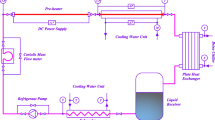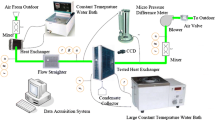Abstract
The critical heat fluxes (CHFs) of two-phase closed thermosyphons with and without fins were studied. The thermosyphons were fabricated using 1.25-mm-thick iron tubes with inner diameters of 16, 21 and 26 mm. The lengths of the evaporator, adiabatic, and condensation sections were 20, 10 and 20 cm, respectively. Pure water, ethanol, and R134a refrigerant were used as the working fluids with 50 % filling rate of the evaporation length. CHF data when using fins of different thicknesses (1.0, 1.5 and 2.0 mm), radii (5, 10 and 15 mm), and spacing (10, 20 and 30 mm) were recorded. The CHF increased with the fin thickness and radius but decreased with the increase in fin spacing. In addition, the CHF increased with the diameter of the thermosyphon tube. Overall, the CHF of thermosyphons with fins was higher than that of thermosyphons without fins regardless of the working fluid.
Similar content being viewed by others
References
Y. Katto, Critical heat flux, Int. J. Multiphase Flow, 20 (1994) 53–90.
T. Kumada and H. Sakashit, Proposed model for Kutateladze correlation and new correlation of CHF, Pool and External Flow Boiling (Edited by DHIR, V. K. & BERGLES, A. E.), ASME, New York (1994) 177–183.
M. Monde and T. Inoue, Critical heat flux in saturated forced convective boiling on a heated disk with multiple impinging jets, Trans. ASME J. Heat Transfer, 113 (1991) 722–727.
Y. Katto and T. Hirao, Critical heat flux of counter-flow boiling in a uniformly heated vertical tube with a closed bottom, Int. J. Heat Mass Transfer, 34 (1991) 993–1001.
C. Konishi and I. Mudawar, Review of flow boiling and critical heat flux in microgravity, Int. J. Heat Mass Transfer, 80 (2015) 469–493.
Y. Kim, J. Choi, S. Kim and Y. Zhang, Effects of mass transfer time relaxation parameters on condensation in a thermosyphon, Journal of Mechanical Science and Technology, 29 (12) (2015) 5497–5505.
S. Juengjaroennirachon, N. Pratinthong, P. Namprakai and T. Suparos, Performance enhancement of air conditioning using thermosyphon system’s energy storage unit for cooling refrigerant before entering the condenser, Journal of Mechanical Science and Technology, 31 (1) (2017) 393–400.
C. Ladekar, S. K. Choudhary and S. S. Khandare, Experimental investigation for the optimization of heat pipe performance in latent heat thermal storage, Journal of Mechanical Science and Technology, 31 (6) (2017) 2627–2634.
N. Siriwan, T. Chompookham, Y. Ding and S. Rittidech, Heat transfer predictions for helical oscillating heat pipe heat exchanger:Transient condition, Journal of Mechanical Science and Technology, 31 (7) (2017) 3553–3562.
S. H. Oh, J. W. Choi, K. J. Lee, W. P. Jeon, H. H. Cho and S. I. Kim, Experimental study on heat transfer performance of a two-phase single thermosyphon using HFE-7100, Journal of Mechanical Science and Technology, 31 (10) (2017) 4957–4964.
H. Bilirgen, S. Dunbar and E. K. Levy, Numerical modeling of finned heat exchangers, Applied Thermal Engineering, 61 (2013) 278–288.
B. Jiao, L. M. Qiu, X. B. Zhang and Y. Zhang, Investigation on the effect of filling ratio on the steady-state heat transfer performance of a vertical two-phase closed thermosyphon, Applied Thermal Engineering, 28 (2008) 1417–1426.
T. Payakaruk, P. Teedtoon and S. Ritthidech, Correlation to predict heat transfer characteristic of an inclined closed twophase thermosyphon at normal operating conditions, Applied Thermal Engineering, 20 (2000) 781–790.
D. Ristoiu, T. Ristoiu, C. Cosma and D. Cenan, Experimental investigation of inclination angle on heat transfer characteristics of closed two-phase thermosyphon, BPU-5th general conference of the Balkan Physical Union, 25-29 August (2003) 1643–1646.
Y. Zhao, Z. Qi, Q. Wang, J. Chen and J. Shen, Effect of corrosion on performance of fin-and-tube heat exchangers with different fin materials, Experimental, Thermal and Fluid Science, 37 (2012) 98–103.
B. Kuźnicka, Erosion-corrosion of heat exchanger tubes, Engineering Failure Analysis, 16 (2009) 2382–2387.
S. H. Lee, J. G. Kim and J. Y. Koo, Investigation of pitting corrosion of a copper tube in a heating system, Engineering Failure Analysis, 17 (2010) 1424–1435.
H. Imura, K. Sasaguchi, H. Kozai and S. Numata, Critical heat flux in a closed two-phase thermosyphon, Int. J. Heat Mass Transfer, 26 (1983) 1181–1188.
M. Monde, Y. Mitsutake, A. Kurihara and S. Mihara, Analytical study of critical heat flux in two-phase thermosyphon: Relationship between maximum falling liquid rate and critical heat flux.Trans, JSME International Journal Series B Fluids and Thermal Engineering, 39 (1996) 768–779.
M. Ashraful Islam, M. Monde and Y. Mitsutake, CHF characteristics and correlations of concentric-tube open thermosyphon with R22, Int. J. Heat and Mass Transfer, 48 (2005) 4615–4622.
Author information
Authors and Affiliations
Corresponding author
Additional information
Recommended by Associate Editor Youngsuk Nam
Wasan Pinate is a post doctor of Heat- Pipe and Thermal Tools Design Research Unit, Department of Mechanical Engineering, Faculty of Engineerig Mahasarakham University, Kantarawichai District, MahaSarakam province, Thailand 44000.
Sampan Rittidech is a Lecturer of Heat-Pipe and Thermal Tools Design Research Unit, Department of Mechanical Engineering, Faculty of Engineerig Mahasarakham University, Kantarawichai District, MahaSarakam province, Thailand 44000.
Pattanapol meena is a Lecturer of Department of Physics, Faculty of Science Mahasarakham University, Kantarawichai District, MahaSarakam province, Thailand 44000.
Rights and permissions
About this article
Cite this article
Pinate, W., Rittidech, S. & meena, P. Critical heat flux of a two-phase closed thermosyphon with fins. J Mech Sci Technol 32, 2357–2364 (2018). https://doi.org/10.1007/s12206-018-0447-7
Received:
Revised:
Accepted:
Published:
Issue Date:
DOI: https://doi.org/10.1007/s12206-018-0447-7




